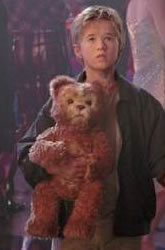Science Fiction
Dictionary
A B C D E F G H I J K L M N O P Q R S T U V W X Y Z
Huggable Robotic Bear Companion From MIT

Huggable, the robotic companion for therapeutic applications, is the result of an MIT project that seeks to take advantage of our love for animals. Research indcates that animal companionship benefits people; they can lower our stress, reduce heart rate and respiratory rate, elevate mood and facilitate greater socialization with other people.

(Huggable Robotic Bear Companion for Therapeutic Applications)
However, there are many situations where animals are not welcome, due to allergies, risk of disease or institutional requirements (in hospitals and nursing homes).
The MIT team has created a huggable robotic bear that can interact with patients and provide quantitative information to care givers.
The Huggable robotic therapeutic companion makes use of a variety of cutting-edge technologies:
- The full-body sensate skin consists of three different types of sensors - electric field, temperature and force - that cover the entire surface of the robot. (The sensor-skin lies under a silicone skin and plush fur fabric for greater comfort.) This is may be an improvement over earlier efforts to give robots pressure-sensitive skin or electroluminescent thin film sensors.
- An inertial measurement unit, cameras embedded in the eyes and microphones in the ears.
- Voice coil actuators with position sensing give the Huggable silent, compliant and backlash-free movement in the neck, shoulders and face.
- An embedded PC with wireless communication capabilities implements the robots behaviors and provides care givers with effective patient monitoring and efficient data collection.
"One important and novel capability we are developing for the Huggable is its ability to participate in active relational and affective touch-based interactions with a person. Social-relational touch interactions play a particularly important role for companion animals in their ability to provide health benefits to people. Touch can convey a wide variety of communicative intents --- an animal can be tickled, petted, scratched, patted, rubbed, hugged, held in ones arms or lap just to name a few. To be effective, therapeudic robotic companions must also be able to understand and appropriately respond to how a person touches it ."
Science fiction fans have been looking forward to these developments for generations. In his 1969 story Super-Toys Last All Summer Long (the basis for Steven Spielberg's A.I.), writer Brian Aldiss imagines Teddy, a perfect robotic companion for a young boy. And a mother.
"Stand there, Teddy. I want to talk to you." She set him down on a tabletop, and he stood as she requested, arms set forward and open in the eternal gesture of embrace."Teddy, did David tell you to tell me he had gone into the garden?"
The circuits of the bear's brain were too simple for artifice. "Yes, Mummy."
(Read more about Brian Aldiss' Teddy bear robot

(Teddy the robotic companion from A.I.)
An earlier (and somewhat more sinister) vision of robotic teddy bears is provided in Always Do What Teddy Says, a 1965 short story by Harry Harrison. Also, physicians have been using robot stand-ins for rounding; read InTouch Companion: Medical Rounding Robot. Read more about MIT's Huggable Robotic Companion.
Update 02-Aug-06: Excellent reference from a reader - see Purza the Pukha from Anne McCaffrey's The Rowan.
Scroll down for more stories in the same category. (Story submitted 8/2/2006)
Follow this kind of news @Technovelgy.| Email | RSS | Blog It | Stumble | del.icio.us | Digg | Reddit |
Would
you like to contribute a story tip?
It's easy:
Get the URL of the story, and the related sf author, and add
it here.
Comment/Join discussion ( 11 )
Related News Stories - (" Robotics ")
Artificial Skin For Robots Is Coming Right Along
'... an elastic, tinted material that had all the feel and appearance of human flesh and epidermis.' - Harl Vincent (1934)
Robot Guard Dog On Duty
I might also be thinking of K-9 from Doctor Who.
Wearable Artificial Fabric Muscles
'It is remarkable that the long leverages of their machines are in most cases actuated by a sort of sham musculature...' HG Wells, 1898.
Dancing Robots Taught Dance Moves
'A clockwork figure would be the thing for you...' Jerome K. Jerome, 1893.
Technovelgy (that's tech-novel-gee!) is devoted to the creative science inventions and ideas of sf authors. Look for the Invention Category that interests you, the Glossary, the Invention Timeline, or see what's New.
Science Fiction
Timeline
1600-1899
1900-1939
1940's 1950's
1960's 1970's
1980's 1990's
2000's 2010's
Current News
The Zapata Air Scooter Would Be Great In A Science Fiction Story
'Betty's slapdash style.'
Thermostabilized Wet Meat Product (NASA Prototype)
There are no orbiting Michelin stars. Yet.
Could Crystal Batteries Generate Power For Centuries?
'Power could be compressed thus into an inch-square cube of what looked like blue-white ice'
India Ponders Always-On Smartphone Location Tracking
'It is necessary... for your own protection.'
Amazon Will Send You Heinlein's Knockdown Cabin
'It's so light that you can set it up in five minutes by yourself...'
Is It Time To Forbid Human Driving?
'Heavy penalties... were to be applied to any one found driving manually-controlled machines.'
Replace The Smartphone With A Connected Edge Node For AI Inference
'Buy a Little Dingbat... electropen, wrist watch, pocketphone, pocket radio, billfold ... all in one.'
Artificial Skin For Robots Is Coming Right Along
'... an elastic, tinted material that had all the feel and appearance of human flesh and epidermis.'
Robot Guard Dog On Duty
I might also be thinking of K-9 from Doctor Who.
Wearable Artificial Fabric Muscles
'It is remarkable that the long leverages of their machines are in most cases actuated by a sort of sham musculature...'
BrainBridge Concept Transplant Of Human Head Proposed
'Briquet’s head seemed to think that to find and attach a new body to her head was as easy as to fit and sew a new dress.'
Google's Nano Banana Pro Presents Handwritten Math Solutions
'...copy was turned out in a charming and entirely feminine handwriting.'
Edible Meat-Like Fungus Like Barbara Hambly's Slunch?
'It was almost unheard of for slunch to spread that fast...'
Sunday Robotics 'Memo' Bot Has Unique Training Glove
'He then started hand movements of definite pattern...'
Woman Marries Computer, Vonnegut's Dream Comes True
'Men are made of protoplasm... Lasts forever.'
Natural Gait With Prosthetic Connected To Nervous System
'The leg was to function, in a way, as a servo-mechanism operated by Larry’s brain...'
